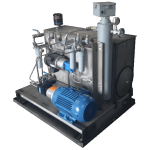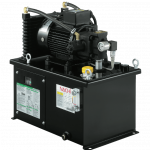Smart Hydraulic Systems Are The Future
Technology is increasing at an unstoppably fast rate. Hydraulic systems are no different. The frequency with which they are used and the magnitude of the jobs they perform necessitate constant updates to their mechanisms. Anything that increases their capabilities or reduces their usages can be very advantageous to the companies that use them.
With the emergence of smartphones, smart watches, and even smart clocks, comes smart hydraulic systems. There are many different ways this technology is being integrated into hydraulic systems including valves, sensors, and actuators.
But how do they work? And how do they compare to older versions of the mechanisms?
Actuators
At their most basic, actuators control and move a mechanism or system. An example of this is opening a valve. A signal and energy source are required for the movement–historically this energy has come from hydraulic pressure, pneumatic pressure, or an electrical current. And even with all their advantages, each of these energy sources has some disadvantages:
Hydraulic Pressure
- Difficult to control motion
- Fluid can become contaminated leading to maintenance issues
- Energy inefficient
- Requires extensive engineering
Pneumatic Pressure
- Infrastructure often leaks, leading to wasted energy
- Required periodic maintenance
- Additional disadvantages similar to hydraulic pressure
Electromechanical Current
- Mechanical wear leads to reduced reliability
- Expensive
- Difficulty regulating force
- Contamination can lead to a reduction in service quality
However, the advent of smart hydraulic actuators addresses and improves upon these inefficiencies. They essentially combine the advantageous aspects of electromechanical and hydraulic systems. Hydraulics are able to provide higher levels of power and strength than the other systems. Electromagnetic systems make use of servo systems which convert energy into motion that can be precisely controlled. These smart hydraulic actuators can be used in robotic technology because this technology frequently needs high levels of force control. Smart hydraulic systems allow for strong, yet detailed movements.
Visit Air & Hydraulic Equipment, Inc. to see how they can help you with your hydraulic systems.
Smart Hydraulic Drive Systems
A hydraulic drive system typically consists of three parts.
- A hydraulic pump driven by an electric motor or combustible engine which acts as the generator of force
- Pipes, valves, and filters to control and guide the system
- An actuator to direct it
A smart hydraulic pump affords many advantages over the traditional system. First, it’s more versatile. The ability to alter the way in which your system works allows different functionalities. A smart pump can be programmed to operate at full capacity when necessary, and to dial back the power when it’s not. This ability to alter the amount of energy used leads to conservation of this energy.
Conservation leads to the next advantage of a smart system—increased efficiency. Different levels of energy mean different output, but not all jobs are created equal. The ability to tailor your machinery to a particular job can actually lead to more work being done in a shorter amount of time. Increased efficiency means a reduction of wasted time and materials which leads to increased profits.
Smart hydraulic pump systems are smoother. This means they reduce the amount of noise and vibration produced while they operate. Less noise means increased safety for your workers. And decreased vibration means the system doesn’t get worn down as quickly as it would otherwise. This means the system requires less maintenance over its lifespan.
Hydraulic systems are powerful. The more control you have over the way it operates, the more you can be sure it’s working the way you need it to. Placing sensors throughout the system gives you the opportunity to ensure the pump is regulating the pressure and flow necessary for each stage in the machine’s cycle.
The Future
Hydraulic systems are here to stay. They can’t be matched when it comes to high power density. They are simply able to create massive amounts of force with even a small amount of fluid. In order to produce a comparable output, a completely electric system would need much larger components. This is why hydraulic systems are generally more cost-effective, as well. Unfortunately, as we stated earlier, there are some potential drawbacks to hydraulic systems.
This is where the introduction of smart components comes into play—taking the power from hydraulic systems and adding intelligent technologies to monitor the equipment while it operates. This helps ensure everything is working the way it should while also being able to potentially predict equipment failure before it even happens.
The potential advantages from smart hydraulic systems will only continue to increase as technologies improve. More companies will use them, more improvements will be made, and the industry will move toward incorporating this technology at increasingly frequent rates.
Are you in need of help installing or maintaining hydraulic systems? Visit Air & Hydraulic Equipment, Inc. today!










